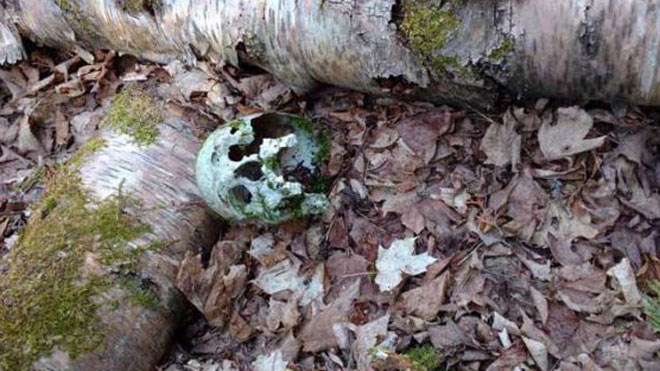Ever since a moss-encrusted human skull rolled down a hill and through forest debris lining a Mindemoya path to land wedged against a tree in front of shocked Mindemoya nature photographer Jamie Pyette, members of the community have been wondering about the history of the human remains, according to report from the Manitoulin Expositor by Michael Erskine.
This week, the skull revealed a few of its secrets, although many more will likely remain hidden for eternity.
“We finally received a report back from the forensic facility in the US where the samples had been sent for analysis,” noted Island Coroner Dr. Shelagh McRea of Gore Bay when contacted by The Expositor. “It was centuries old, centuries,” she noted.
In fact, the person whose remains were discovered last May is thought to have walked the earth some 800 to 900 years ago. “It is similar to the remains found in Providence Bay a few years ago,” she said. That age dates the skull to long before first contact between First Nations and Europeans took place.
The skull most likely belonged to an adult male and to add to the mystery, it is believed the skull’s original resting place was not where it was eventually discovered. The plant life on the skull, and the fact of its sheer survival through nearly the near-millennium since the death of its owner, mitigate against the remains having been exposed to the elements for a significant period of time.
“In this climate, over that length of time, it would have deteriorated a long time ago,” surmised the coroner.
Now that the remains have been identified as being ancient, and not the result of a recent mishap, the role of the police and the coroner’s office are over, explained Dr. McRae. “It is now in the hands of the registrar of burials.”
“This discovery was just reported to me and I am currently initiating the process, which will include notification of the nearest indigenous community to the site where the remains were found,” said Nancy Watkins, senior policy advisor and analyst and Registrar of Burial Sites, War Graves, Abandoned Cemeteries and Cemetery Closures with the Ministry of Government and Consumer Services (MGCS). The previous pre-contact remains that had been discovered in M’Chigeeng a number of years ago were placed in the care of M’Chigeeng First Nation and buried with reverence and care under the direction of Sheguiandah elder Gordon Waindubence in a M’Chigeeng gravesite.
Mr. Pyette was pleased to learn that there was more to the story about his discovery when contacted Monday by The Expositor. “Wow,” he said when told how old the skull was estimated to be. Mr. Pyette is still venturing out into the woods to find subject matter for his popular nature calendars, undeterred by his slightly grisly discovery last fall. These days, however, he splits his shutterbug time with his job at Mindemoya Home Hardware.
This story originally appeared in The Manitoulin Expositor on May 31, 2017.
